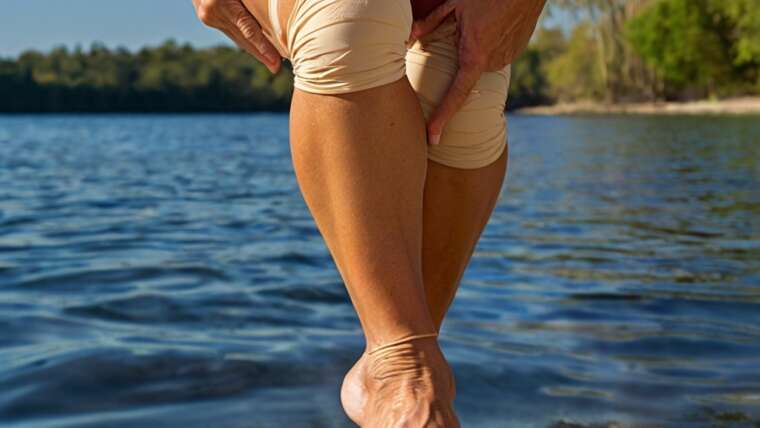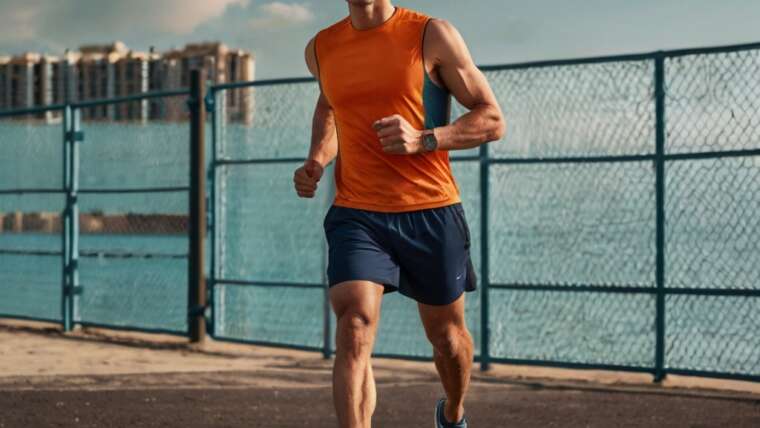The Hoka Arahi 6 weighs only 9.4oz (266g), making it an incredibly light stability shoe that helps curb overpronation. Many runners who need mild to moderate stability support for their daily training have chosen this model, especially those dealing with plantar fasciitis.
The shoe’s men’s and women’s versions share similar cushioning technology. A robust midsole made from compression molded EVA foam gives exceptional protection. The Arahi 6’s updated upper design makes it 11g lighter than the previous version. Both regular and wide versions provide great support with 34mm of cushioning in the heel and 29mm in the forefoot, creating a 5mm drop. The shoe’s signature J-frame stability technology helps curb overpronation while keeping the weight down.
This detailed Hoka Arahi 6 review shows how these popular stability shoes hold up after 500 miles of real-life running. Whether you’re looking at the Hoka One One Arahi 6 for daily training or checking out women’s options, this analysis gives you insights from extensive testing in a variety of conditions and distances.

Table of Contents
Design and Build Quality After 500 Miles
The Hoka Arahi 6’s engineered mesh upper shows remarkable durability after 500 miles of steady running. The lightweight upper keeps its shape and structure well. It still provides good airflow in different weather conditions, even after months of heavy use.
Upper material and breathability
The Arahi 6 uses a lightweight engineered mesh with recycled materials in its lining. This makes this stability shoe better for the environment. The upper design balances breathability and support through different thickness zones. The mesh still breathes well after many miles and prevents hot spots on longer runs.
The Arahi 6’s upper stands out because it keeps its shape even after high mileage. The material stretches just enough to adapt to foot movement while providing the support you need. This version feels softer than the previous model and still maintains excellent ventilation.
The upper barely shows wear after 500 miles, except for some fraying near the lace eyelets. This small issue doesn’t hurt performance but shows how many miles you’ve put on these shoes.
Tongue, heel collar, and lockdown
The plush tongue design remains excellent after hundreds of miles. It stays well-padded and spreads lace pressure evenly across your midfoot. Runners training for marathons especially appreciate how the gusseted design keeps the tongue from sliding during long runs.
The Arahi 6’s heel collar stays comfortable throughout extended use, unlike many stability shoes that get stiff over time. The long heel pull tab helps you put the shoes on easily and protects your Achilles. The somewhat stiff heel counter gives you stability without pressure points. Runners who don’t like rigid heel structures should be careful though.
The well-designed lacing system keeps your midfoot locked in place even after many miles. The laces contain 30% recycled polyester and keep their strength and ability to hold tension during long-term use.
Durability of outsole and midsole
The outsole holds up well with minimal wear patterns after 500 miles. The rubber coverage measures just 2.1mm thick, which might concern heavier runners or those with aggressive foot strikes about lasting beyond 350 miles.
The dual-density midsole with Hoka’s J-Frame technology shows expected wear patterns after extensive use. The compression-molded EVA foam starts to compact around 300 miles. This creates a slightly firmer ride. Most EVA-based midsoles show this pattern, but the Arahi 6 shows it more clearly.
You’ll know the midsole foam is reaching its limit when you notice:
- Deeper compression lines in the sidewall
- Less bounce and response during runs
- Your legs feel more tired after distances that used to feel comfortable
The Hoka Arahi 6 keeps most of its support features through 500 miles. This impressive durability puts it ahead of many other stability shoes in its class.

Cushioning and Stability Performance
The Hoka Arahi 6 brings together stability and comfort in a way that makes it different from regular motion control shoes. After 500 miles of testing, its special cushioning and support features continue to show impressive results.
J-Frame support system explained
The Hoka Arahi 6’s stability comes from its innovative J-Frame technology. This firmer density foam wraps around the heel and runs along the shoe’s medial side in a J shape. You can spot this design by its contrasting color against the rest of the midsole. Unlike regular stability shoes with rigid medial posts, the J-Frame guides your foot without feeling stiff or restrictive.
This technology helps overpronators throughout their stride. The J-Frame runs the full length of the shoe and resists medial motion while staying flexible. This complete approach to stability makes both women’s and men’s models work well for runners who need mild to moderate pronation control.
The stability advantages go beyond the medial side. The J-shaped design guides the lateral heel area too, which creates a supportive cradle that centers your foot. This two-sided approach plus the shoe’s wide base and Active Foot Frame give you stability without feeling bulky.
Meta-Rocker geometry and its effect
The J-Frame works with the Early Stage Meta-Rocker geometry to change how the shoe moves through your stride. The toe spring sits further back than usual designs, which creates an earlier forward roll and smoother transitions.
The Meta-Rocker combines with the EVA midsole to help quick and efficient toe-offs and landings. This shape tips runners forward naturally, which speeds up heel-to-toe transitions and makes the shoe feel responsive despite its thick cushioning.
Reviews often praise the shoe’s smooth transitions and easy ride. Many note they “didn’t feel heavy or clunky like some stability shoes do”. The rocker design works great for long runs and helps maintain good form even when tired.
How the cushioning feels over time
The shoe starts with a CMEVA foam midsole that protects your feet well. It has a stack height of 32.6mm in the heel and 28.5mm in the forefoot. The cushioning feels firmer than it looks. Lab tests show a durometer reading of 49HA – firmer than typical running shoes at 41.4HA.
This firmness creates cushioning that works great for daily training and recovery runs without feeling mushy or wobbly. The midsole absorbs shock well while staying responsive, which makes both wide and standard versions good for long distances.
The J-Frame keeps guiding your foot gently even after hundreds of miles. While the foam packs down over time, the stability features last longer than many similar shoes.
Cold weather affects these shoes more than others. They become 41.6% stiffer in cold conditions compared to the usual 33.1% industry average. Runners in cold places should expect a firmer ride during winter.
The cushioning works perfectly for daily training and recovery but lacks the bounce needed for speed work. One reviewer mentioned the shoe has “a little bit of responsiveness, but not quite enough for a speed workout or tempo run”. This makes the Hoka Arahi 6 better suited for building weekly mileage rather than racing.
Fit and Comfort for Different Foot Types
Runners testing the Hoka Arahi 6 have mixed experiences with finding their perfect fit. Their foot shape plays a big role, and many need to try different sizes before they make their final choice.
Toe box space and width options
The Hoka Arahi 6’s toe box measures 98.5mm – 1mm wider than the previous model. Many runners with wider feet found the toe box “quite tight” and said their feet “never really did have a chance to relax on the run”. This tight fit seems planned, as the forefoot keeps that slightly tapered shape you’ll see in most Hoka shoes.
The good news is that both men’s and women’s versions come in regular and wide options. This choice matters a lot since the standard width runs “normal to slightly narrow” based on what expert testers say. The mesh upper stretches enough to handle foot swelling on longer runs, but runners with broader feet should look at the wide version.
Midfoot lockdown and heel fit
The Arahi 6 really shines with its midfoot security. A well-gusseted tongue and smart lacing system work together to hold your foot steady without needing super tight laces. Runners praise how the lacing works with the upper, saying it “provided plenty of security without being tied down too tight”.
The heel features a moderately stiff counter that adds stability, plus an extended heel tab that makes the shoe easy to put on and protects your Achilles. One runner with “thin heels” liked “the heel’s high build”. Some runners noticed sensitivity on the inner heel area, which might come from the J-Frame’s inner support.
Experience for flat feet and overpronators
The Arahi 6 has become a favorite among flat-footed runners. The J-Frame system blends naturally with the shoe’s design, making it feel “almost like a stable neutral shoe”. A flat-footed runner who overpronates on one side but runs neutral on the other found “the gentle guidance to be beneficial” without affecting their neutral stride.
Overpronators get targeted support without the stiffness common in other stability shoes. The J-Frame stops your foot from rolling inward too much but doesn’t mess with your natural running style. This makes the shoe great for runners who overpronate differently in each foot.
Runners between sizes or those with foot issues like bunions should try both regular and wide options. Some users noticed the sizing felt different compared to older Arahi models.
Real-World Running Experience
The Hoka Arahi 6 stability shoe proved its worth after I logged 500 miles in it. This reliable workhorse weighs just 9.4oz (266g) and feels lighter than most stability shoes, even on long runs.
Performance on long runs
The Arahi 6 really comes into its own during extended runs. Its thick cushioning absorbs shock amazingly well. Runners’ legs feel less sore after weekend long runs. The shoe’s Meta-Rocker geometry creates a smooth rolling motion that works better as the miles add up, making it perfect for runs beyond 10km.
The shoe stands out because it blends stability and comfort on long runs perfectly. The J-Frame support system guides your feet gently without feeling restrictive. This feature becomes crucial when your form starts to break down in the later miles of marathon training. Both men’s and women’s models keep their supportive feel even past the 12km mark without getting too stiff.
Use for daily training and recovery
The Arahi 6 adapts well to everyday training needs. Fleet Feet reviewers added these shoes to their rotation mainly for easy runs and recovery days. The wide platform and firm yet protective cushioning make the wide version a great choice for recovery runs after tough workouts or races.
The shoe has a substantial stack height of 32.6mm in the heel and 28.5mm in the forefoot. Yet it stays relatively firm, which helps with stability during daily runs. This firmness keeps the shoe from feeling mushy like other max-cushioned options.
Responsiveness at different paces
The Arahi 6 has some speed limitations. Fleet Feet testers found that it gives “a little bit of responsiveness, but not quite enough for a speed workout or tempo run”. The Early Stage Meta-Rocker design creates smooth transitions that don’t feel “heavy or clunky like some stability shoes do”.
The shoe responds surprisingly well during half marathon pace segments in long runs. The Hoka One One Arahi 6 ended up being a solid trainer for about 80-90% of weekly mileage and works best at easy to recovery paces. Most runners might want something more responsive for serious speedwork.
How It Compares to Other Stability Shoes
The Hoka Arahi 6 stands apart from other models when we look at stability features. Runners need to understand these key differences to find the right stability shoe that matches their needs.
Hoka Arahi 6 vs Hoka Gaviota 5
The Hoka Gaviota 5 packs more cushioning and maximum stability compared to the Arahi 6. This makes it a perfect choice for runners who need extra support. The Gaviota’s H-Frame support system wraps around the entire midsole with an interlocking center piece, which is different from Arahi’s J-Frame. The Gaviota 5’s wider fit works better for runners with broader feet. The Arahi 6 weighs 20-30g less, which lets you run at various speeds. Pick the Arahi 6 if you want a responsive, lightweight trainer. Go for the Gaviota 5 when you need maximum cushioning on those long, slow runs.
Hoka Arahi 6 vs Brooks Adrenaline GTS 24
Brooks Adrenaline GTS 24 gives you a firmer ride with more pronounced medial posting for stability. The heel drop shows a big difference—5mm in the Hoka Arahi 6 and 12mm in the Brooks Adrenaline. Each shoe takes its own approach to stability. The Arahi uses J-Frame technology while Brooks employs its GuideRail system with firmer foam on both sides of the heel. The Adrenaline feels more traditional in its support, while both men’s and women’s Hoka Arahi 6 models provide stability without getting in your way.
Is it worth upgrading from Arahi 5?
Arahi 5 owners might wonder about the value of an upgrade. The midsole, cushioning, and overall feel under your feet stay almost the same between versions. The upper material sees some improvements, but these changes don’t really affect how the shoe performs. The outsole thickness might raise some eyebrows – it dropped from 3.7mm in the Arahi 5 to 2.1mm in the Arahi 6.
Summing all up
We tested the Hoka Arahi 6 for over 500 miles and found it to be an impressive stability shoe that combines lightweight performance with great overpronation control. This versatile shoe works great as a daily trainer and delivers amazing comfort on long runs. You’ll also get enough responsiveness for your moderate-paced efforts.
The J-Frame technology is without doubt the Arahi 6’s biggest strength. It offers gentle correction without feeling rigid like traditional stability shoes. The Meta-Rocker geometry also creates smooth transitions that help runners of all experience levels, especially when you have plantar fasciitis or need mild to moderate support.
Most parts of the shoe are quite durable, and the upper holds up really well. The thinner 2.1mm outsole might not last beyond 350 miles for heavier runners. The cushioning gets firmer after 300 miles, but the stability features keep working effectively.
Your foot shape should guide your buying decision. Runners with wider feet should definitely check out the Arahi 6 wide option. If you need maximum stability, the Hoka Gaviota 5 might work better for you. Current Arahi 5 owners don’t need to upgrade unless they’re having issues with the upper.
The Arahi 6 shines as a reliable workhorse for daily training and recovery runs, though it’s not ideal for serious speedwork. Most runners can use this shoe for 80-90% of their weekly training with great comfort. The lightweight build, effective stability features, and consistent performance through high mileage make the Hoka Arahi 6 perfect for overpronators who want a dependable, comfortable training partner.
Here are some FAQs about the Hoka Arahi 6:
What are Arahi 6 Hokas good for?
The hoka arahi 6 women’s model excels as a stability running shoe designed for overpronators needing mild-to-moderate support. With its J-Frame technology, the arahi 6 hoka provides guidance without heavy medial posts, making it ideal for daily training and long runs. Many hoka arahi 6 review articles highlight its perfect balance of cushioning and stability for runners seeking injury prevention.
What makes HOKA shoes so special?
HOKA’s signature maximalist cushioning sets them apart, and the hoka arahi 6 exemplifies this with its plush yet responsive foam midsole. The arahi 6 hoka specifically incorporates unique stability features like the J-Frame system that differentiates it from other brands. Reviews of the hoka arahi 6 wide version praise how HOKA manages to combine substantial cushioning with relatively lightweight designs.
Are HOKA Arahi for flat feet?
Yes, the hoka arahi 6 is particularly well-suited for runners with flat feet thanks to its built-in arch support and stability features. The hoka arahi 6 wide option provides extra room for flatter foot types that tend to splay more during impact. Many hoka arahi 6 review testimonials from flat-footed runners report excellent comfort and reduced fatigue during long runs.
Which is better Bondi or Arahi HOKA shoes?
While both are excellent, the arahi 6 hoka is better for runners needing stability, whereas the Bondi series offers maximum cushioning for neutral runners. The hoka arahi 6 women’s model provides more structured support compared to the Bondi’s plush neutral ride. Your choice between hoka arahi 6 and Bondi depends on whether you prioritize stability (Arahi) or pure cushioning (Bondi).
Are arahis good for running?
Absolutely, the hoka arahi 6 is specifically designed for running, offering the perfect blend of cushioning and stability for daily training. The hoka arahi 6 review community consistently praises its smooth ride and supportive feel across various distances. Whether you’re a beginner or seasoned runner, the arahi 6 hoka delivers reliable performance mile after mile.
What are the best hokas for being on feet all day?
For all-day comfort, the hoka arahi 6 stands out with its supportive J-Frame and cushioned midsole that reduces fatigue. The hoka arahi 6 wide version is especially popular among healthcare workers and others who stand for long periods. While the Bondi offers more cushion, the arahi 6 hoka provides better stability for prolonged standing and walking shifts.
Are HOKA shoes really worth it?
Based on numerous hoka arahi 6 review evaluations, HOKAs deliver excellent value for runners and walkers needing premium cushioning and support. The arahi 6 hoka specifically justifies its price with durable construction, innovative stability features, and exceptional comfort. While pricier than some brands, the hoka arahi 6 women’s and men’s models consistently receive high marks for quality and performance from both casual and serious runners.


